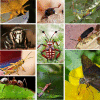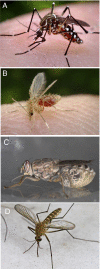Insect olfaction from model systems to disease control
- PMID: 21746926
- PMCID: PMC3156210
- DOI: 10.1073/pnas.1103472108
Insect olfaction from model systems to disease control
Abstract
Great progress has been made in the field of insect olfaction in recent years. Receptors, neurons, and circuits have been defined in considerable detail, and the mechanisms by which they detect, encode, and process sensory stimuli are being unraveled. We provide a guide to recent progress in the field, with special attention to advances made in the genetic model organism Drosophila. We highlight key questions that merit additional investigation. We then present our view of how recent advances may be applied to the control of disease-carrying insects such as mosquitoes, which transmit disease to hundreds of millions of people each year. We suggest how progress in defining the basic mechanisms of insect olfaction may lead to means of disrupting host-seeking and other olfactory behaviors, thereby reducing the transmission of deadly diseases.
Conflict of interest statement
The authors declare no conflict of interest.
Figures





References
-
- Shanbhag SR, Muller B, Steinbrecht RA. Atlas of olfactory organs of Drosophila melanogaster—1. Types, external organization, innervation and distribution of olfactory sensilla. Int J Insect Morphol Embryol A. 1999;28:377–397.
-
- McIver SB. Sensilla of mosquitoes (Diptera: Culicidae) J Med Entomol. 1982;19:489–535. - PubMed
-
- Sanes JR, Hildebrand JG. Structure and development of antennae in a moth, Manduca sexta. Dev Biol. 1976;51:280–299. - PubMed
-
- Shields VDC, Hildebrand JG. Responses of a population of antennal olfactory receptor cells in the female moth Manduca sexta to plant-associated volatile organic compounds. J Comp Physiol A Neuroethol Sens Neural Behav Physiol. 2001;186:1135–1151. - PubMed
Publication types
MeSH terms
Substances
Grants and funding
LinkOut - more resources
Full Text Sources
Other Literature Sources
Medical
Molecular Biology Databases

